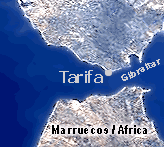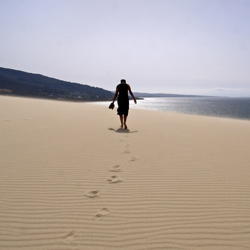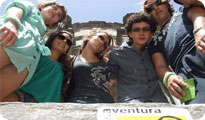 Bilingual Summer Camps in Tarifa Bilingual Summer Camps in Tarifa
Spanish - and English camps in Tarifa, your Destination in Spain
Tarifa is situated in Andalusia at the Costa de la Luz. All people visiting for the first time are astonished by the bright light that dominates this coast as well as the extraordinary view that await the visitor. Looking out on the ocean on a sunny day the African continent is clearly visible and facing inland Tarifa surprises with soft green hills.
An additional highlight is the fact that Tarifa is on the most southern tip of Europe. Here in this beautiful town where the Atlantic meets the Mediterranean ocean is where our Spanish - and English camps take place. The distance from M�laga to Tarifa is 170 kilometers and from Sevilla to Tarifa 195 kilometers.
Be part of our sports camp spain this summer.
 Due to our privileged geographical location a huge amount of different species of birds stop here in autumn and springtime before leaving for Africa or going back to their home countries. Not only the birds consider Tarifa the port of the Mediterranean, but also Paulo Coelho, the famous Brazilian writer mentioned it in his book "The Alchemist." Due to our privileged geographical location a huge amount of different species of birds stop here in autumn and springtime before leaving for Africa or going back to their home countries. Not only the birds consider Tarifa the port of the Mediterranean, but also Paulo Coelho, the famous Brazilian writer mentioned it in his book "The Alchemist."
Not to forget about the 10 Kilometers of white sand beaches, crystal clear water, exceptional cultural traditions, untouched nature and boundless outdoor adventure - and sports activities, such as kitesurfing, sport climbing, whale and dolphin watching, etc. All that makes Tarifa a fascinating and exciting adventure for all participants of our summer camps.
Mass tourism has never made it here thanks to the conservation parks, which prevent the construction of large hotels along the beach. The last few years though Tarifa has become one of the most visited towns in Southern Spain due to its easygoing, simple style and its individualism. Young and sporty people from all over the world, but also from other parts of Spain, give Tarifa a colorful face.
Despite all this influence from outside, Tarifa with its 18'000 inhabitants, is still very traditional. The old part of the town shows the Arabic influence and the narrow white alleys invite guests to reminisce about the past.
|





 Bilingual Summer Camps in Tarifa
Bilingual Summer Camps in Tarifa  Due to our privileged geographical location a huge amount of different species of birds stop here in autumn and springtime before leaving for Africa or going back to their home countries. Not only the birds consider Tarifa the port of the Mediterranean, but also Paulo Coelho, the famous Brazilian writer mentioned it in his book "The Alchemist."
Due to our privileged geographical location a huge amount of different species of birds stop here in autumn and springtime before leaving for Africa or going back to their home countries. Not only the birds consider Tarifa the port of the Mediterranean, but also Paulo Coelho, the famous Brazilian writer mentioned it in his book "The Alchemist."

